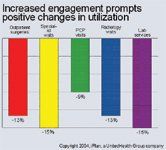Study identifies HRA potential and the next set of challenges
The study indicates HRA products can induce positive health behavior changes.

THE STUDY The report summarizes the experience of three employers by following 16,000 enrollees who moved from a traditional plan in 2002 to UnitedHealth Group's iPlan product in 2003. Although the design varied among the employers, all three offered an iPlan product that combines an HRA with catastrophic medical expense coverage and separate comprehensive benefits for preventive services.
Employer A offered the iPlan product alongside various Preferred Provider Organizations (PPOs), with the iPlan product having the highest employee contribution.
Employer B offered the iPlan product alongside an Exclusive Provider Organization (EPO), Point-of-Service (POS) plan, and a PPO.

Employer C offered the iPlan product only, after offering an EPO, POS and PPO in 2002. This employer based its HRA (ranging between $300 and $1,800) on length of employment, regardless of contract type.
Because of this structure, the HRA accounted for between 20% and 120% of the deductible, which was $1,000 for medical and $500 for drugs. Prescription drugs were included.
ANALYSIS AND OBSERVATIONS While the report contains analyses of the experience of each individual employer, it also looked at the experience across all three employers.
Among the observations:
On a "paid claim" basis, all three employers showed a savings or no claim-cost trend compared with the previous year. This probably occurred due to slightly lower benefits and changing consumer behavior. (Paid claims are defined as amounts paid from the catastrophic coverage and the HRA in 2003 compared with the benefit paid claims in 2002.)
When the outstanding HRA balance was conservatively added to paid claims (since this is a potential employer liability), the cost trend ranged between -0.3% and 11%, which is still well below the 12% to 18% trends that predominated nationwide.
Among the three employers, the number of employees carrying over a balance ranged between 33% and 74% of the iPlan population.
For those employers offering the product on a "slice" basis (as one choice among several), the iPlan product attracted a better selection of health risk, higher-income employees, and more families; the degree of each was dependent on the employee contribution for the iPlan product.
In general, the iPlan product yielded a reduction in utilization, especially in office visits, emergency room, outpatient surgeries and prescription drugs.
David Calabrese of OptumRx Talks New Role, Market Insulin Prices and Other Topics 'On His Mind'
April 13th 2023In this month’s episode of the "What's On Your Mind podcast," Peter Wehrwein, managing editor of MHE connects with the now Chief Clinical Officer of OptumRx Integrated Pharmacies, David Calabrese. In this conversation, David touches on his transition in January as OptumRx’s former chief pharmacy officer and market president of health plans and PBMs to his new role as Chief Clinical Officer where he now focuses more on things such as specialty pharmacy to home delivery — with an overall goal of creating whole-patient care. Throughout the conversation, Calabrese also touched on the market’s hot topic of insulin prices and behavioral health services within the OptumRx community, among other topics.
Listen
Upended: Can PBM Transparency Succeed?
March 6th 2024Simmering tensions in the pharmacy benefit management (PBM) industry have turned into fault lines. The PBMs challenging the "big three" have formed a trade association. Purchaser coalitions want change. The head of the industry's trade group says inherent marketplace friction has spilled over into political friction.
Read More
Briana Contreras, editor of Managed Healthcare Executive, spoke with Nancy Lurker, CEO and president of EyePoint Pharmaceuticals. Nancy shared a bit about EyePoint and how the organization’s innovative therapies are addressing patient needs through eye care, and most importantly, she addressed C-Suite positions like the CEO role. Nancy shared advice for those seeking to reach the CEO level, especially toward women in healthcare and other roles, and what it takes to run a biopharma company.
Listen
The deliberate disconnection of Change Healthcare to ring fence a cyberattack entered its seventh day today. Prescribers are finding ways to get pharmacy claims processed, and UnitedHealth Group says disruption to the dispensing of prescriptions has been minimal. But independent pharmacies want more information and protection from financial consequences from pharmacy benefit managers.
Read More